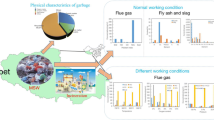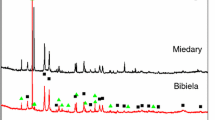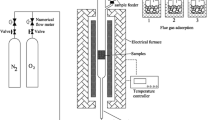Abstract
Gasification is widely regarded as one of the most practical, economical, and environmentally friendly waste disposal technologies for municipal solid waste (MSW). The pyrolysis stage (300–500 °C) is crucial for weight loss during MSW gasification, as a considerable amount of organic matter breaks down, producing high-value synthesis gas. This study investigated the product distribution and pollutant emission characteristics within this temperature range and its influencing factors during MSW gasification using a self-designed MSW gasification device. Results indicated that MSW underwent approximately 70% weight loss within this temperature range, yielding low amounts of inorganic and short-chain organic products, with mainly long-chain organic compounds of C16–C34. The atmosphere variation had minimal effect on the elemental composition and content of solid phase products. X-ray fluorescence spectrometry (XRF) and inductively coupled plasma mass spectrometry (ICP-MS) analyses showed that Mn and Zn were the primary components of heavy metal leaching toxicity in solid phase products, with their contents increasing as temperature increased. Synthesis gas showed the highest content of heavy metal As element, reaching a peak at 400 °C. Higher gasification temperature and lower oxygen flow rate significantly reduced the dioxin content and I-TEQ values, with highly chlorinated isomers being the predominant dioxin isomers. Nonetheless, low-chlorinated dioxins accounted for more than 50% of the I-TEQ. This study improves our understanding of the gasification process of MSW.













Similar content being viewed by others
Data availability
Present study data are available with corresponding author and are available on reasonable request.
References
Arena U (2012) Process and technological aspects of municipal solid waste gasification A review. Waste Manag 32:625–639
Assima GP, Marie-Rose S, Lavoie J-M (2018) Role of fixed carbon and metal oxides in char during the catalytic conversion of tar from RDF gasification. Fuel 218:406–416
Begum S, Rasul MG, Akbar D (2014) A numerical investigation of municipal solid waste gasification using Aspen Plus. Procedia Eng 90:710–717
Boerrigter H, Rauch R, Knoef H (2005) Handbook biomass gasification. BTG biomass technology group, Enschede, The Netherlands
Cai J, Zeng R, Zheng W, Wang S, Han J, Li K, Luo M, Tang X (2021) Synergistic effects of co-gasification of municipal solid waste and biomass in fixed-bed gasifier. Process Saf Environ Prot 148:1–12
Cai P, Fu J, Zhan M, Jiao W, Chen T, Li X (2022) Formation mechanism and influencing factors of dioxins during incineration of mineralized refuse. J Clean Prod 342:130762
Chen S, Meng A, Long Y, Zhou H, Li Q, Zhang Y (2015) TGA pyrolysis and gasification of combustible municipal solid waste. J Energy Inst 88:332–343
Chen L, Hu J, Han Q, Xie A, Zhou Z, Yang J, Tang Q, Mi B, Wu F (2022) Application of distributed activation energy model and Coats-Redfern integration method in the study of industrial lignin pyrolysis kinetics. Biomass Convers Biorefin 1–11
China Statistical Yearbook (2023) National Bureau of Statistics of China. China Statistics Press. https://www.stats.gov.cn/sj/ndsj/2023/indexch.htm. Accessed 26 Dec 2023
Cumming JW (1984) Reactivity assessment of coals via a weighted mean activation energy. Fuel 63:1436–1440
Ding Y, Zhao J, Liu J-W, Zhou J, Cheng L, Zhao J, Shao Z, Iris Ç, Pan B, Li X (2021) A review of China’s municipal solid waste (MSW) and comparison with international regions: management and technologies in treatment and resource utilization. J Clean Prod 293:126144
Dong J, Chi Y, Tang Y, Ni M, Nzihou A, Weiss-Hortala E, Huang Q (2016) Effect of operating parameters and moisture content on municipal solid waste pyrolysis and gasification. Energy Fuels 30:3994–4001
Higman C, Tam S (2014) Advances in coal gasification, hydrogenation, and gas treating for the production of chemicals and fuels. Chem Rev 114:1673–1708
Huang H, Buekens A (1995) On the mechanisms of dioxin formation in combustion processes. Chemosphere 31:4099–4117
Kaupp A (2013) Small scale gas producer-engine systems. Eschborn, Germany
Kawaguchi K, Miyakoshi K, Momonoi K (2002) Studies on the pyrolysis behavior of gasification and melting systems for municipal solid waste. J Mater Cycles Waste Manag 4:102–110
Li Q, Meng A, Jia J, Zhang Y (2010) Investigation of heavy metal partitioning influenced by flue gas moisture and chlorine content during waste incineration. J Environ Sci 22:760–768
Li D, Lei S, Wang P, Zhong L, Ma W, Chen G (2021) Study on the pyrolysis behaviors of mixed waste plastics. Renew Energy 173:662–674
Liu Z (2019) Gasification of municipal solid wastes: a review on the tar yields. Energy Sources Part A: Recover Utilization Environ Eff 41:1296–1304
Malika A, Jacques N, Jaafar EF, Fatima B, Mohammed A (2016) Pyrolysis investigation of food wastes by TG-MS-DSC technique. Biomass Convers Biorefinery 6:161–172
McKay G (2002a) Dioxin characterisation, formation and minimisation during municipal solid waste (MSW) incineration: review. Chem Eng J 86:343–368
McKay G (2002b) Dioxin characterisation, formation and minimisation during municipal solid waste (MSW) incineration. Chem Eng J 86:343–368
Nanda S, Berruti F (2021) A technical review of bioenergy and resource recovery from municipal solid waste. J Hazard Mater 403:123970
Qin J, Zhang Y, Heberlein S, Lisak G, Yi Y (2022) Characterization and comparison of gasification and incineration fly ashes generated from municipal solid waste in Singapore. Waste Manag 146:44–52
Saffarzadeh A, Shimaoka T, Motomura Y, Watanabe K (2006) Chemical and mineralogical evaluation of slag products derived from the pyrolysis/melting treatment of MSW. Waste Manag 26:1443–1452
Skodras G, Grammelis P, Basinas P, Kakaras E, Sakellaropoulos G (2006) Pyrolysis and combustion characteristics of biomass and waste-derived feedstock. Ind Eng Chem Res 45:3791–3799
Soria-Verdugo A, Goos E, García-Hernando N, Riedel U (2018) Analyzing the pyrolysis kinetics of several microalgae species by various differential and integral isoconversional kinetic methods and the Distributed Activation Energy Model. Algal Res 32:11–29
de Souza-Santos ML (2004) Solid fuels combustion and gasification: modeling, simulation. Sao Paulo, Brazil
Stieglitz L, Vogg H (1987) On formation conditions of PCDD/PCDF in fly ash from municipal waste incinerators. Chemosphere 16:1917–1922
Šuhaj P, Husár J, Haydary J (2020) Gasification of RDF and its components with tire pyrolysis char as tar-cracking catalyst. Sustainability 12:6647
Vehlow J (2005) Dioxins in waste combustion–conclusions from 20 years of research. Melbourne, Australia
Velghe I, Carleer R, Yperman J, Schreurs S (2011) Study of the pyrolysis of municipal solid waste for the production of valuable products. J Anal Appl Pyrol 92:366–375
Vergara SE, Tchobanoglous G (2012) Municipal solid waste and the environment: a global perspective. Annu Rev Environ Resour 37:277–309
Wang J, Cheng G, You Y, Xiao B, Liu S, He P, Guo D, Guo X, Zhang G (2012) Hydrogen-rich gas production by steam gasification of municipal solid waste (MSW) using NiO supported on modified dolomite. Int J Hydrogen Energy 37:6503–6510
Xue Y, Yang T, Liu X, Cao Z, Gu J, Wang Y (2023) Enabling efficient and economical degradation of PCDD/Fs in MSWIFA via catalysis and dechlorination effect of EMR in synergistic thermal treatment. Chemosphere 342:140164
Yu J, Sun L, Xiang J, Hu S, Su S (2013) Kinetic vaporization of heavy metals during fluidized bed thermal treatment of municipal solid waste. Waste Manag 33:340–346
Zhang Q, Dor L, Fenigshtein D, Yang W, Blasiak W (2012) Gasification of municipal solid waste in the Plasma gasification melting process. Appl Energy 90:106–112
Zheng X, Ying Z, Wang B, Chen C (2018) Hydrogen and syngas production from municipal solid waste (MSW) gasification via reusing CO2. Appl Therm Eng 144:242–247
Zhou C, Stuermer T, Gunarathne R, Yang W, Blasiak W (2014) Effect of calcium oxide on high-temperature steam gasification of municipal solid waste. Fuel 122:36–46
Funding
This work was supported by “Pioneer” and “Leading Goose” R&D Program of Zhejiang (No.2023C03157) and the Zhejiang students’ technology and innovation program (XinMiao RenCai program), China (2023R409A053).
Author information
Authors and Affiliations
Contributions
Shi Feng carried out experiment and wrote the manuscript. Yu-Han Feng researched literature. Long-jie Ji, Ming-Xiu Zhan, and Xu Xu checked the manuscript. Jin-Qing Wang edited and reviewed. All authors read and approved the final manuscript.
Corresponding author
Ethics declarations
Ethical approval
Not applicable.
Consent to participate
Not applicable.
Consent for publication
Not applicable.
Competing interests
The authors declare no competing interests.
Additional information
Responsible Editor: Philippe Garrigues
Publisher's Note
Springer Nature remains neutral with regard to jurisdictional claims in published maps and institutional affiliations.
Supplementary Information
Below is the link to the electronic supplementary material.
Rights and permissions
Springer Nature or its licensor (e.g. a society or other partner) holds exclusive rights to this article under a publishing agreement with the author(s) or other rightsholder(s); author self-archiving of the accepted manuscript version of this article is solely governed by the terms of such publishing agreement and applicable law.
About this article
Cite this article
Feng, S., Feng, YH., Ji, Lj. et al. Distribution of gasification products and emission of heavy metals and dioxins from municipal solid waste at the low temperature pyrolysis stage. Environ Sci Pollut Res 31, 16388–16400 (2024). https://doi.org/10.1007/s11356-024-32284-3
Received:
Accepted:
Published:
Issue Date:
DOI: https://doi.org/10.1007/s11356-024-32284-3




